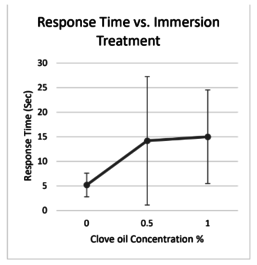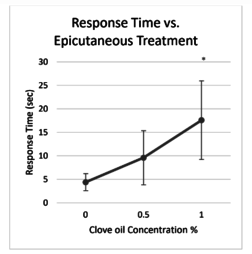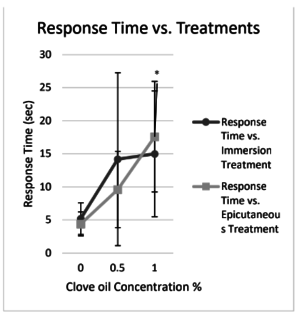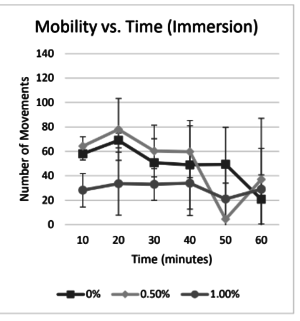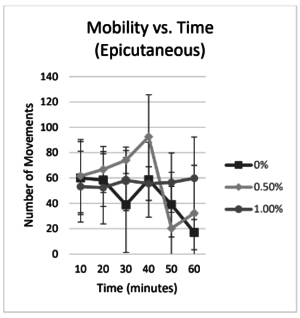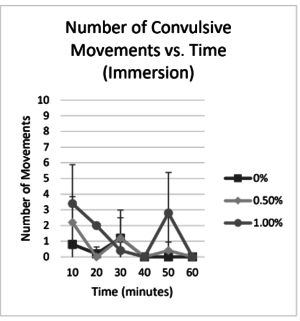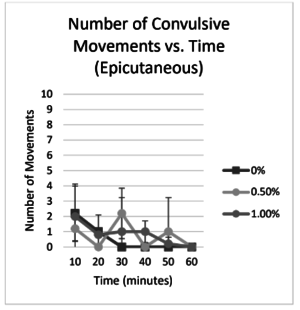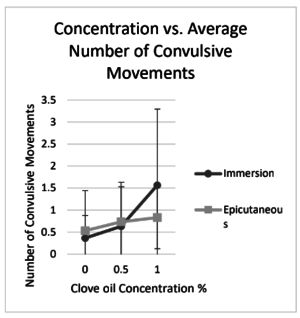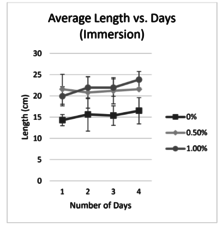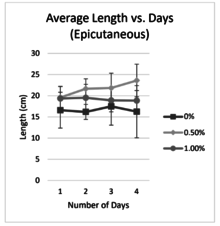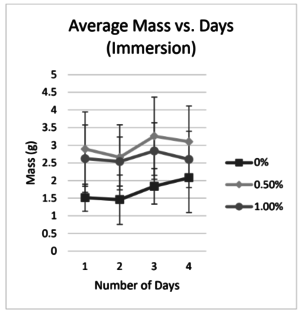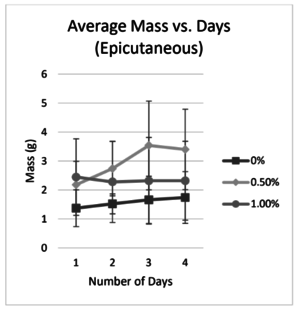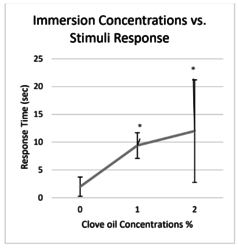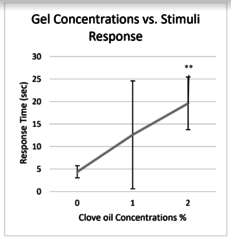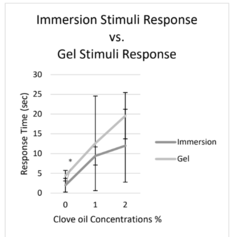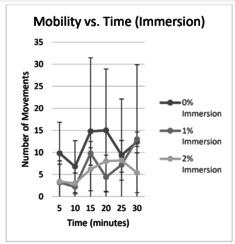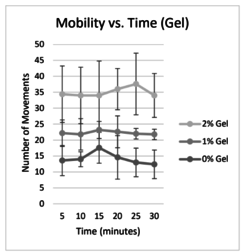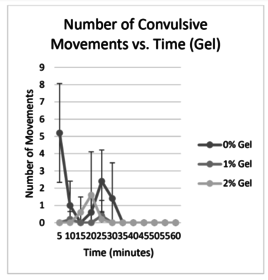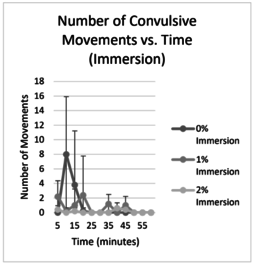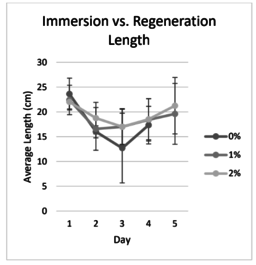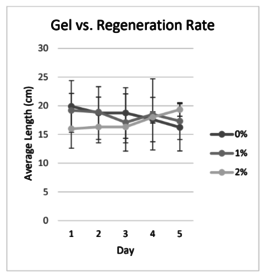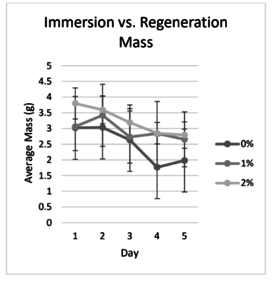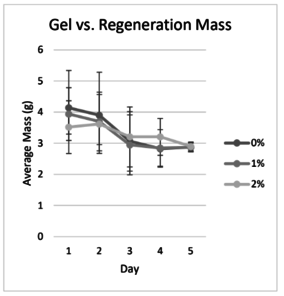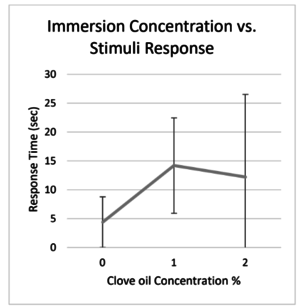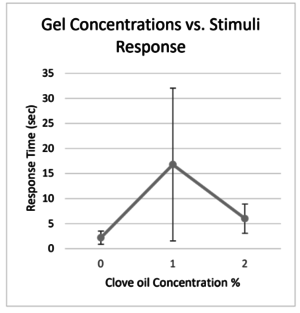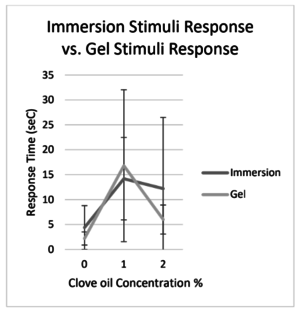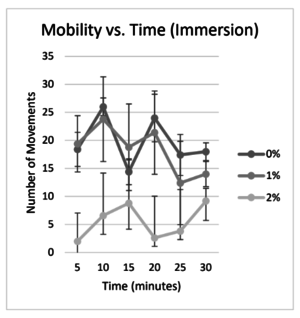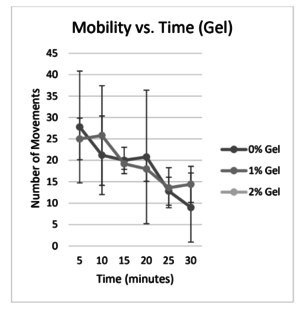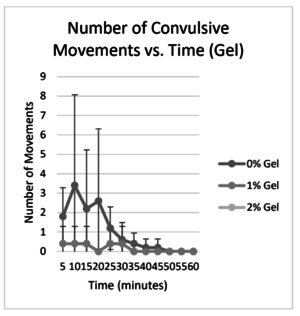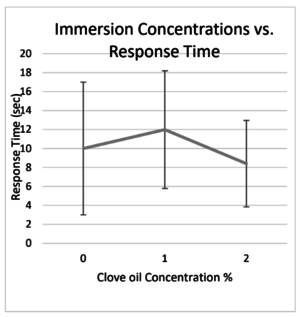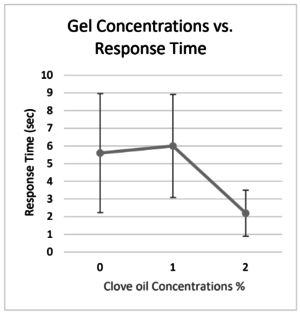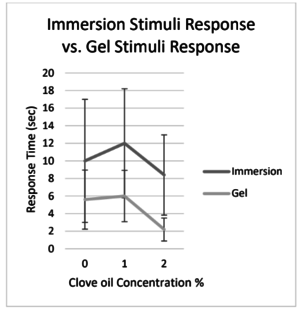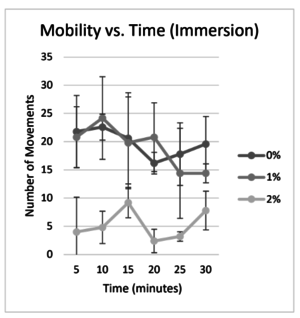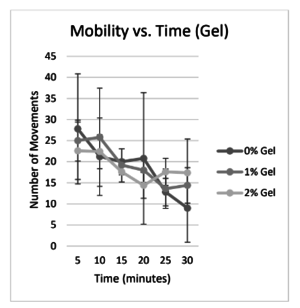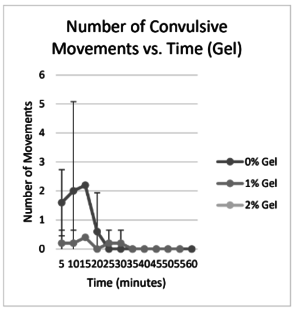Abstract
Clove oil, Eugenia caryophyllata, has been implemented as home therapeutic medicine for its anesthetic effects. The active ingredient, eugenol inhibits voltage gated sodium channels, hence sedating as an anesthetic. Clove oil provides an alternative for synthetic analgesics including morphine. The typical application of clove oil consists of topical application through liquid immersion. In addition to liquid, emulsification gel application allows for another form of controlled penetrative topical drug delivery. Moreover epicutaneous application through microneedles allowed for a non-invasive administrative method of delivering clove oil between the cuticle and epidermis. Earthworms Lumbricus terrestris were the specimens tested due to their complex neurological functionalities. Mobility, convulsions, stimuli response, regeneration, and mortality were evaluated with concentrations of 0%, 1%, 2%, 3% with gel/immersion, and additional 0.5% with epicutaneous application. Different components of the experiment were conducted within a time-span of three years. 1% epicutaneous was shown to sedate the stimuli response of earthworms at an extremely fast rate. Furthermore 1% clove oil of all administration methods were the most effective as compared to lower concentrations 0.5% and higher concentrations 2%-3%. None of the administrative methods or concentrations of clove oil application caused limitations in regeneration, convulsive movements, or increased rate in mortality. The limitations of this experiment consist of not consistently regulating the temperature of the medium. Future implications consist of more trials for validation and evaluating vaporization as another potential application. 1% epicutaneous showed an efficient form of sedation without severe behavioral and physiological complications.
Introduction
Anesthesia
Anesthesia is utilized in modern day medicine for the purpose of protective analgesia, in a wide variety of invasive and noninvasive surgical procedures. Local and general anesthesia are common forms of treatment that are primarily used for the surgical repairment of open traumas. The complexity of anesthesia inhibition and safety are crucial factors that need to remain constant to prevent post-surgical complications. Current research suggests that certain forms of steroidal anesthesia are detrimental to the physiological characteristics of less complex species to even humans. Research on the steroid injections in the cervical spinal region of a human were demonstrated as a leading cause of neurological infarct, a neurological compilation associated with tissue necrosis (Otani et al., 2015). Moreover, more common forms of local and general anesthesia were demonstrated to hinder factors of the morphological as well as the behavioral functionalities of less complex organisms, such as annelids. It was established that lidocaine and prilocaine, through immersion administration, causes coelomocyte extrusion and erratic behavior in earthworms (Yeo et al., 2017). Therefore, this demonstrates that anesthesia administration must be potent as well as safe when treating an organism undergoing surgical procedures. In addition to limiting the usage of certain synthetic anesthetics, offering individuals a wider selection of anesthesia would prevent complications such as drug relapse. As an example, individuals at risk for drug relapse cannot get treated with psychotropic anesthetics such as morphine (Jouppila et al., 1981). Overall, the issues of certain forms of modern day local synthetic anesthetics prompt the necessity of a holistic alternative.
Clove oil
It is not one of the most broadly known herbs, however clove oil has numerous utilizations as an anticarcinogenic, antioxidant, and as an analgesic supplement. Clove oil may serve as a replacement for an anesthetic that is separated from Clove Syzygium aromaticum. Clove oil is derived from an herb that initially originates from India. Clove oil is utilized for an assortment of purposes, including as an antimicrobial, to help eliminate microscopic organisms, and as a pain reliever, to ease respiratory conditions, etc. (Foldvari, 1996). Syzygium aromaticum contains an active chemical agent known as eugenol, which has comparable characteristics to a local anesthetic, thus making it a holistic anesthetic with antibacterial properties. Eugenol an active agent, and phenolic compound in clove oil can be compared to local anesthetics. Eugenol has the potency to inhibit voltage-gated sodium channels (VGSC), which are neurological receptors that are responsible for the communication of neurons as well as cells throughout the body and activation of transient receptor potential vanilloid subtype 1 (TRPV1), which shows sedative effects (Scheu, 1991). Moreover, prior studies demonstrated that low concentrations of clove oil assist in lowering the levels of stress while not altering the cardiovascular response of the aquatic organisms during transportation (Koritsánszky & Hartwig, 1974). Furthermore, the topical application of clove oil in dentistry exemplifies another administration method of clove oil that is deemed as safe and effective (Podolak-Machowska et al., 2013). Since clove oil is popular in dentistry because of its soothing properties, it is available over the counter at a drugstore. There are multiple studies that suggest clove oil as a topical and local anesthetic for minor oral health issues such as toothaches. Clove oil has the potency to sedate a small portion of the mouth as a local anesthetic replacement with buccal patch serratiopeptidase (Srivastava et al., 2016). Along with toothaches, cloves are alleviating the pain of dry socket, a typical circumstance that can occur from teeth extractions (Podolak-Machowska et al., 2013).
According to the previous experiment that was conducted regarding establishing an appropriate concentration of clove oil, it was demonstrated that the 1% concentration of clove oil was effective in sedating as a local and general anesthetic at a fast rate without causing any behavioral complications. Such results established that lower concentrations of clove oil were more effective and did not cause any neurological deficiencies. In this experiment, the concentrations of clove oil consisted of 0%, 0.5%, and 1%, based on how the 1% was demonstrated as efficient and safe.
Earthworms
The organism that was utilized for this experiment is earthworm, Lumbricus terrestris. Earthworm's bodies are composed of ring-like portions called annuli. These portions are shrouded in setae, or little fibers, which the worms use for mobility. Furthermore, earthworms are viewed as one of the most suitable specimens for ecotoxicological testing (Shende et al., 2016). Although these annelids are one of the simpler preserved invertebrates, the digestive, circulatory, reproductive, and nervous systems are well-evolved and simple to recognize, making them ideal specimens. Specifically, the earthworms have a structure known as the cerebral ganglia that was comparable to the human brain, as they both control all the bodily functions that can range from stimuli response to regeneration (Alemán Navas & Martínez Mendoza, 2010). Additionally, earthworms have comparable skin layers with humans because they are both used for protection and excretion (Morteza-Semnani et al., 2021). Overall, there were several indistinguishable attributes, contributing to one of the main purposes of this experiment which was to evaluate the earthworm's neurological complex characteristics to establish their similarities with humans. In addition to mobility and physical behavior, Lumbricus terrestris are flexible invertebrates that have the physical ability to self-regenerate after trauma (Sullivan & Seladi-Schulman, 2019). The regeneration ability of earthworms was determined by its neurological attributes, which can be affected by anesthesia. Therefore, the regeneration process and the regeneration rate were also investigated in this experiment. Regeneration was an important aspect to examine to distinguish any side effects that can possibly harm or benefit the earthworms. Additionally, regeneration represents a surgical procedure which allows the correlation between tissue healing and growth to be identified.
Immersion
Clove oil immersion is an anesthesia administration method that is comparable to topical application. Immersion consists of the process of submerging an organ or an organism in an anesthetic solution to sedate. Specifically, clove oil immersion in earthworms consists of submerging tail annuli, thus making it effective without hindering any organs such as the cerebral ganglia. Although immersion is a noninvasive form of anesthesia administration, it only sedates moderately compared to vaporization or intravenous venipuncture. Research has demonstrated that topical application of local anesthetics is noninvasive because they do not cause any histopathological changes, however, are only somewhat effective since they are only applied on mucosal and skin barriers (Scanlon et al., 2007). Immersion is a noninvasive anesthesia application method but is not the most applicable for local anesthesia in more complex organisms including humans.
Epicutaneous
Epicutaneous administration is utilized in immunological, as well as dermatological medicine. This process consists of delivering a substance within the epidermis layer of an organism. Moreover, the wide variety of implications that epicutaneous administration has on delivering a substance in an organism are used to diagnose allergic reactions and to promote skin rejuvenation. In other words, the common purpose behind utilizing this application revolves around medical screening and fortifying an organism’s health. The immunological purposes consist of analyzing the severity of allergens and as a form of immunotherapy. The recognition and reduction of aero and oral allergic responses aref undamental variables that correspond to epicutaneous administration tests (Park et al., 2009); (Birse & Bittner, 1981). Moreover, forms of epicutaneous application consist of derma patching, derma stamping with microneedles (skin pricks), as well derma scratching. Research conducted on utilizing derma patching as a form of topical local anesthesia application for skin grafts as well as labor pain and was suggested as a safer alternative compared to intravenous administration (Adriani & Zepernick, 1964); (Lee et al., 2008). Nevertheless, microneedling and derma scratching have not been utilized to apply analgesics or sedate organisms. Moreover, the dermatological implications of epicutaneous derma stamping, are extremely beneficial towards inducing skin rejuvenation from hypertrophic scarring by delivering serums through a safe and non-invasive manner. Such research indicates that epicutaneous microneedle administration is an effective drug delivery methodology that is noninvasive and efficient. Notably, administering clove oil as a form of local anesthesia through epicutaneous microneedling would indisputably sedate earthworms efficiently and noninvasively.
Nanoemulgel
Medications in the form of gel have a wide variety of benefits in terms of convenience and potency. Specifically applying medications with a gel base allows for a controlled drug delivery. Previous research on medicinal gels such as nanoemulgel shows it aids in drug penetration when applied topically. Specifically, emulsification gel allows for controlled drug delivery through the outermost layer of the epidermis skin layer (Morteza-Semnani et al., 2021). Emulgel is applicable to clove oil treatment based on previous research incorporating clove oil gel for bacterial inhibition. Eugenol was previously utilized as an oil phase in the formulation of a ketoprofen nanoemulgel. It was found that the gel formulation had synergistic antibacterial activity (Srivastava et al., 2016). In other words, clove oil concentrations formulated in gel can allow for an increase in anesthetic efficiency and a controlled drug release system. A form of gel, white petroleum jelly was used to formulate clove oil into a gel application. Petroleum jelly can be utilized as a moisturizing agent as well as drug delivery application. Previous research evaluated petroleum jelly as a vehicle for liposomal drug delivery through skin layers (Foldvari, 1996). A commercialized over-the- counter form of petroleum jelly consists of Vaseline. 100% Petroleum jelly Vaseline was used as a base to establish 0%, 1%, and 2% clove oil concentrations as an emulgel.
Stimulus Response Assay
The stimulus response tests involve measuring the behavioral responses after the initial sedation of the earthworms. These tests were completed in the form of an invasive probe. Normally, hypodermic needles are used to decide how their structure impacts the simplicity of inclusion into the skin, understanding patient pain and skin injury; however, in the last experiment, a toothpick was utilized for safety purposes. Additionally, sharpness was dictated by estimating the penetration power of a probe into a known medium which intently replicates skin. A membrane of uniform thickness was held under constant strain and was repositioned to permit numerous tests to be performed (Sullivan & Seladi-Schulman, 2019). Additionally, a key part of the fixturing was to guarantee that the instrument did not flex during the test and that the angle was constantly the same in order to preserve the validity. Overall stimulus response was utilized to measure the initial reaction of an organism based on physical stimuli.
Materials and Methods
Preparation of Earthworms
The earthworms, L. terrestris, were obtained from the Carolina Biological Website (25/container). The earthworms were kept in a large container with compacted mouse pellets and a Sphagnum moss medium sprinkled with dandelion root tea leaves. The earthworms were separated into bins of groups of fifteen to ensure validity and accuracy within the results. Additionally, this allowed the earthworms to be separated and protected overnight when supervision was not present. The earthworms were organized into different categories based on the type of test administration method; clove oil concentration as shown in Table 1.
Table 1. 1. Group distribution between different concentrations, and assays (2020-2021).
| Type of Anesthesia Administration | Concentration |
|
# of Samples | Types of Assays |
|---|---|---|---|---|
| Immersion | 0%
1.0% 2.0% 3.0% |
15 Earthworms
15 Earthworms 15 Earthworms 15 Earthworms |
5 Earthworms
5 Earthworms 5 Earthworms 5 Earthworms 5 Earthworms 5 Earthworms 5 Earthworms 5 Earthworms 5 Earthworms 5 Earthworms 5 Earthworms 5 Earthworms |
Mobility
Stimuli Response Convulsive Movements Mobility Stimuli Response Convulsive Movements Mobility Stimuli Response Convulsive Movements Mobility Stimuli Response Convulsive Movements |
Table 2. Group distribution between different administration applications, concentrations, concentrations and assays (2021-2022).
| Group# | Type of Anesthesia Administration | Concentration |
|
# of Samples | Types of Assays |
|---|---|---|---|---|---|
| Group A | Immersion | 0%
0.5% 1.0% |
15 Earthworms | 5 Earthworms
5 Earthworms 5 Earthworms |
Mobility
Stimuli Response Convulsive Movements |
| Group B | Epicutaneous Microneedling | 0%
0.5% 1.0% |
15 Earthworms | 5 Earthworms
5 Earthworms 5 Earthworms |
Mobility
Stimuli Response Convulsive Movements |
Table 3. Group distribution between different administration applications, concentrations, and assays (2022-2023).
| Group# | Type of Anesthesia Administration | Concentration |
|
# of Samples | Types of Assays |
|---|---|---|---|---|---|
| Group A | Immersion | 0%
1.0% 2.0% |
15 Earthworms | 5 Earthworms
5 Earthworms 5 Earthworms |
Mobility
Stimuli Response Convulsive Movements |
| Group B | Nanoemulgel | 0%
1.0% 2.0% |
15 Earthworms | 5 Earthworms
5 Earthworms 5 Earthworms |
Mobility
Stimuli Response Convulsive Movements |
Preparation of Gel
The gel treatment of the worms was synthesized using white petroleum jelly as a base or drug delivery vehicle. A beaker was filled with 100g of gel of either pure Vaseline 100% petroleum jelly, 1%, 2% clove oil concentrations (in a ratio to the petroleum jelly). Using a syringe, 1 mL of the gel was squeezed onto ⅓ of the segment of the tail. After applied, the gel was massaged onto the cuticle of the earthworm tail before being evaluated for stimuli response, mobility, or regeneration. Only 1mL of the gel was applied onto the earthworms to ensure that an equal amount of gel is being administered.
Preparation of clove oil Immersion
The immersion treatment was previously prepared with precautionary measures to ensure proper implementation. To establish this administration method efficiently, a beaker was used to hold the clove oil solution. This beaker was filled with 100mL of solution of either pure corn oil, 1%, or 2% clove oil concentrations (in a ratio to corn oil). The earthworm tails (1⁄3 of body segment) were then immersed in the clove oil solutions for 30 seconds. The tails were only immersed to prevent the earthworms from drowning, or any damage to major organs such as the cerebral ganglia. Moreover, the earthworms were placed into a container dedicated to treated groups.
Epicutaneous Microneedling Treatment Protocol
The epicutaneous microneedling procedure was prepared with a ceramic container that was rinsed with water and then filled one fourth of the way with concentrations of 0.5% and 1%, according to the group. The microneedle derma stamp was sourced from Amazon, and the platform of the stamp was sterilized with ethanol prior to usage. The microneedle derma stamp was adjusted to a length of 0.25mm before being dipped into the ceramic container with the specific clove oil concentration. The earthworms were stamped gently on the last 5 annuli rings of their tail region and placed in a container based on the group letter and division that they belonged to. The oil was disposed of with a paper towel, and the derma stamp was rinsed with water, retracted, as well as concealed with a cap.
Regeneration Assay
The regeneration assay was implemented since it demonstrates physiological recovery involving wound healing. The earthworms in the division of the regeneration assay had their tail amputated using a sterilized scalpel. A centimeter from the tip of each tail was removed. Moreover, the length as well as the weight of each of the earthworms were recorded for ten consecutive days post amputation. This was examined to determine the rate of post-traumatic growth in the earthworms that were induced with clove oil anesthesia.
Stimuli Response Assay
The Stimuli Response Assay demonstrates the anesthesia induction rate based on the type of reaction an earthworm displays when pricked gently. After the nanoemulgel or immersion treatment, the earthworms were gently patted dry. Subsequently, the cuticle of the earthworm was probed at a 30-degree angle. A stopwatch was utilized to measure the amount of time it took in seconds for the earthworm to respond to the probe. This evaluated whether the initial stimuli of the earthworms were sedated by the clove oil treatment.
Mobility Assays
The mobility rate identifies the potency of the anesthetic, and its impact on neurological as well as behavioral attributes. The earthworms were measured for convulsive body movements and induction rates based on the number of regular movements through observing their mobility. When observing convulsive body movements, erratic behavior such as S-shaped movements, jumping, curling positions, or violent jolting was recorded. Convulsive body movements were examined in 34.6075 X 20.955 X 12.3825 cm3 containers outlined with wet paper towels. Moreover, the number of regular movements was monitored to measure the rate in which the earthworms were sedated as well as started to recover. Earthworms were dampened with water and placed in a petri dish to observe the induction as well as recovery rate. A recording device was placed for an hour to record the number of movements.
Data Analysis
The data that was collected in this experiment consisted of multiple parts for the data to obtain validity. The data was stored and organized on Microsoft excel. To analyze the data, line graphs were used, which visually showed the trends and patterns that this experiment obtained. The means and standard deviation of the experiment were calculated for the initial response time, number of movements, number of convulsive movements, regeneration rate based on the 1.0% and 2.0% concentrations. Thus, the convulsive body movements were observed based on jumping or a cease in movement. The mortality rate was calculated by the number of dead earthworms over the total amount of earthworms per each of the two groups. The statistical values for regeneration were stored in the Microsoft Excel Spreadsheet to calculate the percentage of growth and variation daily. Most of the graphs that were used consist of line graphs with ± standard deviation bars, for the initial reaction time, average number of normal movements, rate of regeneration in length/mass, and average number of convulsive movements. Lastly, the ANOVA (analysis of variation) followed by Tukey HSD (honest significant difference) was performed to find significant differences using an online website and a platform (http://astatsa.com/OneWay_Anova_with_TukeyHSD/).
Results
2021-2022 Experiment, Immersion vs. Epicutaneous Treatment
There was no significant difference amongst the different concentrations of clove oil immersion treatment (Figure 1.). Nevertheless, the specimen treated with 1% epicutaneous adminstration had a longer response time as compared to the control (p-value<0.05). Earthworm treated with epicutaneous microneedling as compared to both immersion and 0.5% concentration, responded to toothpick probe at a slower rate (Figure 2. and Figure 3.). The mobility of the earthworms treated with 1% concentration of clove oil was limited under an average of 40 movements throughout the whole-time interval. Additionally, 1% treated earthworms tended to have less movement within the first 20 min of the interval as compared to both the control and 0.5% treated group (SD bars did not overlap) (Figure 4.). No significance or trend was found between the mobility of epicutaneous treated earthworms (Figure 5.). In addition to the movement, the number of convulsions for all treated earthworms remained under an average of 4 movements per ten minutes. This shows that the earthworms were not displaying any behavioral signs of stress (Figure 6., Figure 7., Figure 8.,). There were no observable trends on the regeneration lengths and mass between all of the treated specimen. Specifically, clove oil did not inhibit or promote the growth of the earthworms' tail during regeneration (Figure 9., Figure 10., Figure 11., Figure 12.).
2022-2023 Experiment, Immersion vs. Nanoemulgel Treatment
The stimuli response of the earthworms treated with 1% and 2% immersion was significantly longer as compared to the control (P value<0.05) (Trial 1, Figure 13.). Moreover 2% concentration of clove oil in gel had a longer response time as compared to both the immersion groups and other gel concentrations (p value<0.01) (Figure 14., Figure 15., Trial 1). This further implies that a higher concentration of clove oil in gel form is the most efficient in sedating at a faster rate. In addition to response time, earthworms treated with 1% and 2% concentration of clove oil tended to have fewer regular movements throughout an hour time span (Figure 16., Trial 1). On the other hand, earthworms treated with gel concentrations of 1% and 2% concentration tended to have more movement, hence indicating that they were not sedated throughout the hour timespan (Figure 17., Trial 1). Moreover, all forms of clove oil treatment did not induce over 8 convulsive movements throughout the entire hour time span. Typically, the 1% and 2% treated group tended to have the least number of convulsions as compared to the control in every five-minute time interval (Figure 18. and Figure 19., Trial 1). The regeneration (mass and length) of the earthworms remained relatively the same regardless of the concentration and treatment method (Figure 20., Figure 21., Figure 22., Figure 23., Trial 1).
Similarly, as demonstrated in Trial 2, the response time of the earthworms treated with 1% of both gel and immersion tended to have a longer response time (Figure 24., Figure 25., Figure 26. Trial 2). The 2% immersion treatment had the least amount of normal movements as compared to the other treatments in Trial 2, but and Trial 3. (Figure 27. Figure 28 Trial 2). There was no significance amongst the earthworms treated with the varying concentrations of gel treatment. Lastly, all convulsive movements were under 4 within the hour timespan, hence indicating limited behavioral impacts (Figure 29., Trial 2).
In Trial 3, there were similar trends within the behavior of the earthworms. 1% concentration of immersion tended to have the longest delay in response time as compared to the other concentrations and gel treatment (Figure 30., Figure 31. Figure 32., Trial 3). In addition to the stimulus response of the earthworms, the number of normal movements of the earthworms decreased consistently to under 25 within the hour timespan for all concentrations of gel treatment (Figure 33., Trial 3). The number of convulsive movements of the earthworms for all concentrations of gel treatment was under 3 movements (Figure 34., Trial 2). The convulsive and normal movements of the earthworms were not observed in Trial 2 and Trial 3 of the 2022-2023 experiment.
2021-2022
Figure 1. Response Time vs. Immersion Treatment. 15 earthworms in groups of 5 were immersed in concentrations of clove oil treatment ranging from 0%- 1%. The 1% concentration was the most effective in hindering the response time. Error bars represent ±SD.
Figure 2. Response Time vs. Epicutaneous Treatment. 15 earthworms in groups of 5 were immersed in concentrations of clove oil treatment ranging from 0%- 1%. The 1% concentration was the most effective in hindering response time. Based on ANOVA following a Tukey HSD test, the 1% treated group is significant compared to the control group with a *p-value<0.05. Error bars represent ±SD.
Figure 3. Response Time vs. All Treatment Groups. 15 earthworms in groups of 5 were immersed in concentrations of clove oil treatment ranging from 0%- 1%. 1% concentration of epicutaneous treatment was the most effective in hindering response time. Based on ANOVA following a Tukey HSD test, the 1% epicutaneous treated group is significant compared to the control group with a *p-value<0.05. Error bars represent ±SD.
Figure 4. Mobility vs. Time (Immersion). 15 earthworms in groups of 5 were immersed in concentrations of clove oil treatment ranging from 0% to 1%. 1% concentration of the epicutaneous treatment limited the average number of movements to under 40 movements throughout the 60-minute period. Error bars represent ±SD.
Figure 5. Mobility vs. Time (Epicutaneous). 15 earthworms in groups of 5 were immersed in concentrations of clove oil treatment ranging from 0% to 1%. There is no observable difference between the 0% and the 1% as well as 0.5% treated groups for the average number of movements per 10-minute time intervals. Error bars represent ±SD.
Figure 6. Number of Convulsive Movements vs. Time (Immersion). 15 earthworms in groups of 5 were immersed in concentrations of clove oil treatment ranging from 0% to 1%. The average number of convulsive movements stayed consistent throughout the 60-minute time interval. Error bars represent ±SD.
Figure 7. Number of Convulsive Movements vs. Time (Epicutaneous). 15 earthworms in groups of 5 were epicutaneously administered concentrations of clove oil treatment ranging from 0% to 1%. The average number of convulsive movements stayed consistent throughout the 60-minute time interval. Error bars represent ±SD.
Figure 8. Concentration vs. Average Number of Convulsive Movements. 15 earthworms in groups of 5 were immersed in concentrations of clove oil treatment ranging from 0% to 1%. 1% concentration of immersion treatment had the highest average number of convulsive movements. The average number of convulsive movements at other concentrations in both treatments remained consistent. Error bars represent ±SD.
Figure 9. Average Length vs. Days (Immersion). 15 earthworms in groups of 5 were immersed in concentrations of clove oil treatment ranging from 0% to 1%. The rates of regeneration for the 0%, 0.5%, and 1% immersion treated concentrations stayed consistent over the 4-day interval. Error bars represent ±SD.
Figure 10. Average Length vs. Days (Epicutaneous). 15 earthworms in groups of 5 were epicutaneously administered concentrations of clove oil treatment ranging from 0% to 1%. There is no observable difference between the 0%, 1%, and 0.5% treated groups for the average rate regeneration length over the 4-day interval. Error bars represent ±SD.
Figure 11. Average Mass vs. Days (Immersion). 15 earthworms in groups of 5 were immersed in concentrations of clove oil treatment ranging from 0% to 1%. The rate of regeneration at all concentrations in the immersion treatment were consistent over the 4-day interval. Error bars represent ±SD.
Figure 12. Average Mass vs. Days (Epicutaneous). 15 earthworms in groups of 5 were epicutaneously administered concentrations of clove oil treatment ranging from 0% to 1%. The rate of regeneration in the epicutaneously administered concentrations were relatively similar over the 4-day interval. Error bars represent ±SD.
2022-2023
Trial 1
Figure 13. Immersion Concentration vs. Stimuli Response (Trial 1). 15 earthworms in groups of 5 were immersed in concentrations of clove oil treatment ranging from 0%, 1%, to 2%. The 1% concentration of clove oil immersion was the most effective in sedating at a fast rate. Based on ANOVA following a Tukey HSD test, the 1% treated group is significant compared to the control group with a *p-value. 0.05. Error bars represent ±SD.
Figure 14. Gel Concentrations vs. Stimuli Response (Trial 1). 15 earthworms in groups of 5 were treated in concentrations of clove oil gel ranging from 0%, 1%, to 2%. 2% of clove oil gel was the most effective in sedating the stimuli response of the earthworms at a fast rate as opposed to the 1% and 0% concentrations. Based on ANOVA following a Tukey HSD test, the 2% treated group is significant compared to the control group of 0% with a **p-value, 0.01. Error bars represent ±SD.
Figure 15. Immersion Stimuli Response vs. Gel Stimuli Response (Trial 1). 15 earthworms in groups of 5 were treated in concentrations of clove oil gel ranging from 0%, 1%, to 2%. There was no observable difference amongst the gel and immersion treated groups in sedating the earthworms at a fast rate for the 1% and 2% concentrations. Based on ANOVA following a Tukey HSD test, the 0% gel treated group is significant compared to 0% immersion with a *p-value, 0.05. ±SD.
Figure 16. Immersion concentrations vs. Mobility (normal movements) (Trial 1). 15 earthworms in groups of 5 were immersed in concentrations of clove oil treatment ranging from 0%, 1%, to 2%. The 1% and 2% were more effective at sedating the earthworms compared to the 0% group. Error bars represent ±SD.
Figure 17. Gel Concentrations vs. Mobility (normal movements) (Trial 1). 15 earthworms in groups of 5 were treated in concentrations of clove oil gel ranging from 0%, 1%, to 2%. The 2% concentration had the greatest number of movements over time with the gel application. Error bars represent ±SD.
Figure 18. Gel Concentrations vs. Convulsions (Trial 1). 15earthworms in groups of 5 were treated in concentrations of clove oil gel ranging from 0%, 1%, to 2%. Both the 1% and 2% concentrations had less convulsive movements than the 0% group. Error bars represent ±SD.
Figure 19. Immersion Mobility vs. Convulsions (Trial 1). 15 earthworms in groups of 5 were immersed in concentrations of clove oil treatment ranging from 0%, 1%, to 2%. Both the 1% and 2% concentrations had less convulsive movements than the 0% group. Error bars represent ±SD.
Figure 20. Immersion vs. Regeneration Length (Trial 1). 15 earthworms in groups of 5 were immersed in concentrations of clove oil treatment ranging from 0%, 1%, to 2%. All groups regenerated at a similar rate. The decrease in average length on Day 3 is due to the earthworms ejecting their tail. Error bars represent ±SD.
Figure 21. Gel vs. Regeneration Length. 15 earthworms in groups of 5 were treated in concentrations of clove oil gel ranging from 0%, 1%, to 2%. The length of the earthworms stayed consistent throughout the regeneration period of the worms. Error bars represent ±SD.
Figure 22. Immersion vs. Regeneration Mass. 15 earthworms in groups of 5 were immersed in concentrations of clove oil treatment ranging from 0%, 1%, to 2%. The length of the earthworms remains consistent throughout all concentrations. Error bars represent ±SD.
Figure 23. Gel vs. Regeneration Mass. 15 earthworms in groups of 5 were treated in concentrations of clove oil gel ranging from 0%, 1%, to 2%. All groups regenerated at a similar rate. There is a slight decrease in the average mass of the worms throughout the timespan. Error bars represent ±SD.
Trial 2
Figure 24. Immersion Concentrations vs. Response Time (Trial 2). 15 earthworms in groups of 5 were treated in concentrations of clove oil immersion ranging from 0%, 1%, to 2%. The response time of 1% concentration tended to be longer than both 2% and 0% immersion. Error bars represent ±SD.
Figure 25. Gel Concentrations vs Response Time (Trial 2). 15 earthworms in groups of 5 were treated in concentrations of clove oil gel ranging from 0%, 1%, to 2%. 2% of clove oil gel was the most effective in sedating the stimuli response of the earthworms at a fast rate as opposed to the 0% and 2% concentrations. Error bars represent ±SD.
Figure 26. Immersion Stimuli Response vs. Gel Stimuli Response (Trial 2). 30 earthworms in groups of 5 were treated in concentrations of clove oil gel or immersion ranging from 0%, 1%, to 2%. There was no observable difference amongst the gel and immersion treated groups in sedating the earthworms at a fast rate for the 1% and 2% concentrations. Based on ANOVA following a Tukey HSD test, the 0% gel treated group is significant compared to 0% immersion with a *p-value, 0.05. ±SD.
Figure 27. Mobility vs. Time (Immersion) (Trial 2). 15 earthworms in groups of 5 were immersed in concentrations of clove oil ranging from 0%, 1%, to 2%. There is no observable difference between the 0% and 1% concentrations in the sedation of the earthworms. There is an observable trend of a consistent decrease in the number of movements for all concentrations of clove oil. Error bars represent ±SD.
Figure 28. Mobility vs. Time (Gel) (Trial 2). 15 earthworms in groups of 5 were treated in concentrations of clove oil gel ranging from 0%, 1%, to 2%. There is no observable difference between the 0% and 1% concentrations in the sedation of the earthworms. There is an observable trend of a consistent decrease in the number of movements for all concentrations of clove oil. Error bars represent ±SD.
Figure 29. Number of Convulsive Movements vs. Time (Gel) (Trial 2). 15 earthworms in groups of 5 were treated in concentrations of clove oil gel ranging from 0%, 1%, to 2%. The 1% clove oil concentration had less convulsive movements than the 0% group throughout the period of recording. Moreover the 2% group showed no signs of convulsions throughout the 30 minute timespan. Error bars represent ±SD.
Trial 3
Figure 30. Immersion Concentrations vs. Response Time (Trial 3). 15 earthworms in groups of 5 were immersed in concentrations of clove oil ranging from 0%, 1%, to 2%. There is an observable trend that 1% immersion tended to have the most delayed response time. Error bars represent ±SD.
Figure 31. Gel Concentrations vs. Response Time (Trial 3). 15 earthworms in groups of 5 were treated in concentrations of clove oil gel ranging from 0%, 1%, to 2%. The 1% concentration was the most effective in sedating the response time of the earthworms at a fast rate as opposed to the 0% and 2% concentrations. Error bars represent ±SD.
Figure 32. Immersion Stimuli Response vs. Gel Stimuli Response (Trial 3). 30 earthworms in groups of 5 were treated in concentrations of clove oil gel or immersion ranging from 0%, 1%, to 2%. There was no observable difference amongst the gel and immersion treated groups in sedating the earthworms at a fast rate for the 1% and 2% concentrations. Nevertheless the immersion treated worms tended to respond at a slower rate as compared to the gel treated worms. Error bars represent ±SD.
Figure 33. Mobility vs. Time (Immersion) (Trial 3). 15 earthworms in groups of 5 were immersed in concentrations of clove oil ranging from 0%, 1%, to 2%. It can be observed that the 2% concentration of clove oil sedated the earthworms the most (SD error bars do not overlap). In other words the amount of limited movements was limited for the 2% group of earthworms. Error bars represent ±SD.
Figure 34. Mobility vs. Time (Gel) (Trial 3). 15 earthworms in groups of 5 were treated in concentrations of clove oil gel ranging from 0%, 1%, to 2%. There is an observable trend of a decrease in movement throughout the 30 minutes amongst all concentrations. All concentrations had a similar impact on limiting the number of movements after 15 minutes of sedation. Error bars represent ±SD.
Figure 35. Number of Convulsive Movements vs. Time (Gel) (Trial 3). 15 earthworms in groups of 5 were treated with gel in concentrations of clove oil treatment ranging from 0%, 1%, to 2%. The average number of convulsive movements for all three concentrations did not go over 3 movements throughout a 60-minute time duration. Error bars represent ±SD.
Discussion
The 1% concentration of epicutaneous administration was the most effective at sedating the earthworms at a fast rate without hindering earthworm function and behavior. After initially being epicutaneously administered anesthesia, the earthworm’s response to toothpick probe was significantly greater than the control. This indicates that the earthworms responded to external stimuli at an extremely slow rate, directly after being sedated. Nevertheless, there was no notable difference in the epicutaneous administration of any of the concentrations in hindering the rate of mobility. In other words, the 1% epicutaneous administration was able to sedate the tail region of the earthworm, however the change in mobility overall was insignificant. It was concluded that epicutaneous is more effective as a regional anesthetic because after clove oil was administered epicutaneous, the entire tail portion of the earthworm was paralyzed.
As portrayed in previous experimentation (2020- 2021) of testing clove oil as a natural replacement for anesthesia, the results demonstrated that the 1% concentration of clove oil was the most effective in sedating the earthworms at a fast rate, without hindering their behavioral characteristics significantly. The earthworms were most effectively sedated under the 1% and 3% for approximately an hour, while the 2% concentration did not significantly alter the amount of movement compared to the control group. Nevertheless the 1% concentration did not induce a lot of convulsive movements or behavior that was comparable to the control group. Similarly, it was validated the conclusion that low concentrations of clove oil depicted to be safe and portray sedative qualities. Along with this, regeneration was measured, and it was concluded that all the concentrations of clove oil that were tested did not influence regeneration. Furthermore, within the entirety of the experiment, no mortalities were seen, although they were treated with the concentrations. Lastly, the last part of the experiment involved testing the number of convulsions that were seen by the earthworms after administering different concentrations of clove oil, and it was demonstrated that the average number was under 5 convulsions for every 10 minutes for all the concentrations. Moreover, even after an hour timespan, the average number of convulsions for the highest concentration (1.0%) was 1.8.
During the 2022-2023 experimentation, the 1% of clove oil immersion, and 2% of nanoemulgel were effective in sedating the earthworms at a fast rate. After being immersed in 1% clove oil, the earthworms responded to a toothpick probe longer as compared to a high concentration of 2%, and to the control of 0%. Moreover, the 2% concentration for gel was more effective in sedating the initial stimuli response time as compared to 1% as well as 0% gel. Additionally, throughout the course of Trial 1 of the experiment, the base of the nanoemulgel was changed from beeswax to white petroleum jelly. The beeswax solidified at a fast rate, hence making it not suitable for the epidermis and cuticle layer of the earthworms.
Moreover, as examined in all three trials, the number of convulsive movements for both the gel and immersion group of all concentrations remained low under an average of 10 movements throughout an hour duration (Figure 8, Figure 9, Figure 17, Figure 18, Figure 24, Figure 25). This indicates that the topical application of both forms of anesthesia did not induce convulsive behaviors or neurological complications. In addition to convulsive movements, the average number of normal movements (mobility) amongst the gel and immersion groups were similar to each other. In Trial 1, the number of movements for all concentrations and both forms of application tended to remain consistent throughout the 30-minute duration. Nevertheless, for Trial 2 and Trial 3, there is an observable trend indicating that there was a consistent decrease in the average number of movements, especially after the 15-minute time mark. Although the immersion treatment and gel treatment were not distinctive from each other in limiting mobility, there is a pattern of sedation.
Due to time restraints, regeneration in length as well as mass was only evaluated in Trial 1 of the experiment for both the gel and immersion applications. Nevertheless, the clove oil gel and immersion did not have any significant impact on the regeneration rate of the earthworms.
The complications that arose throughout the three experimentations consist of the fact that the petri dishes of the mobility portion of the experiment were not sealed efficiently. As an example, the 0.5% epicutaneous and immersion treated groups were simultaneously recorded together, and during the 10-minute time interval, two earthworms of opposing groups switched petri dishes. No data was recorded for those two earthworms. To prevent earthworms from traveling, petri dishes will be partially taped down. This would prevent instances of earthworms escaping during observation, and missing data. Additionally, due to time constraints in the 2022-2023 experiment, the number of convulsive movements and normal movements within the immersion treated groups were not evaluated for Trial 2 and Trial 3.
Conclusion
To conclude, the epicutaneous administration of 1% concentration of clove oil was effective as a natural sedative without causing any physiological or behavioral complications in earthworms. The 1% concentration with the combination of epicutaneous application impeded the stimulus response of the earthworms directly from treatment. Furthermore, none of the application methods or concentrations caused over an average of 5 convulsions throughout the 60 minutes. Nevertheless, there were no significant differences in the mobility of the earthworms regardless of the treatment. This further indicates that the epicutaneous application was the most effective in sedating at only the tail region of the earthworm at a fast rate.
Future Direction
In terms of future research, vapor administration will also be compared to the epicutaneous and immersion administration methods of clove oil. This would further broaden the variety of administrative techniques as well as applications of Syzygium aromaticum as a natural anesthetic. Vapor administration would provide a method that would involve inhalation as compared to skin application. Overall, further elaborating on different administrative methods of clove oil can promote more of a diversity in the field of anesthesiology.
Acknowledgments
We would like to deeply thank as well as acknowledge Dr. D. Marmor, Mrs. N. Jaipershad, Dr. L. Wang, Dr. J. Cohen, Dr. X. Lin, Mr. Z. Liang, Ms. R. DePietro, Ms. J. Zhu, Ms. A. Khemlani and the Francis Lewis High School Science Department for providing us the support to complete this project.
Funding
This research received no external funding.
Institutional Review Board Statement
Not applicable.
Informed Consent Statement
Not applicable.
Data Availability Statement
Data are contained within the article.
Conflicts of Interest
The authors declare no conflicts of interest.
References
Adriani, J., & Zepernick, R. (1964). Clinical effectiveness of drugs used for topical anesthesia. JAMA, 188(8), 711-716.
Alemán Navas, R. M., & Martínez Mendoza, M. G. (2010). Case report: late complication of a dry socket treatment. International journal of dentistry, 2010.
Birse, S. C., & Bittner, G. D. (1981). Regeneration of earthworm giant axons following transection or ablation. Journal of neurophysiology, 45(4), 724-742.
Foldvari, M. (1996). Effect of vehicle on topical liposomal drug delivery: petrolatum bases. Journal of microencapsulation, 13(5), 589-600.
Jouppila, R., Teramo, K., Ulmsten, U., Purhonen, M., Hollmén, A., Berlin‐Wahlén, A., & Gustafsson, B. (1981). Maternal and foetal drug levels after epicutaneous application of a local anaesthetic formulation containing ketocaine for possible use as pain relief in labour. Acta Anaesthesiologica Scandinavica, 25(1), 73-75.
Koritsánszky, S., & Hartwig, H. (1974). The regeneration of the monoaminergic system in the cerebral ganglion of the earthworm, Allolobophora caliginosa. Cell and Tissue Research, 151(2). https://doi.org/10.1007/bf00222221
Lee, B. T., Shin, K. H., Kim, J. Y., & Kim, K. W. (2008). Progress in earthworm ecotoxicology. In Advanced environmental monitoring (pp. 248-258). Springer, Dordrecht.
Morteza-Semnani, K., Saeedi, M., Akbari, J., Eghbali, M., Babaei, A., Hashemi, S. M. H., & Nokhodchi, A. (2021). Development of a novel nanoemulgel formulation containing cumin essential oil as skin permeation enhancer. Drug Delivery and Translational Research, 1-11.
Otani, I. M., Kuhlen Jr, J. L., Blumenthal, K. G., Guyer, A., & Banerji, A. (2015). A role for vancomycin epicutaneous skin testing in the evaluation of perioperative anaphylaxis. The journal of allergy and clinical immunology. In practice, 3(6), 984.
Park, C. K., Kim, K., Jung, S. J., Kim, M. J., Ahn, D. K., Hong, S. D.,... & Oh, S. B. (2009). Molecular mechanism for local anesthetic action of eugenol in the rat trigeminal system. PAIN®, 144(1-2), 84-94.
Podolak-Machowska, A., Kostecka, J., Librowski, T., & Plytycz, B. (2013). The use of selected anaesthetic drugs in search of a method for improving earthworms’ welfare. Journal of Ecological Engineering, 14(3).
Scanlon, G. C., Moeller-Bertram, T., Romanowsky, S. M., & Wallace, M. S. (2007). Cervical transforaminal epidural steroid injections: more dangerous than we think?. Spine, 32(11), 1249-1256.
Scheu, S. (1991). Mucus excretion and carbon turnover of endogeic earthworms. Biology and Fertility of Soils, 12(3), 217-220.
Shende, P. K., Gaud, R. S., Bakal, R., & Yeole, Y. (2016). Clove oil emulsified buccal patch of serratiopeptidase for controlled release in toothache. Journal of Bioequivalence & Bioavailability, 8, 134-139.
Srivastava, M., Neupane, Y. R., Kumar, P., & Kohli, K. (2016). Nanoemulgel (NEG) of Ketoprofen with eugenol as oil phase for the treatment of ligature-induced experimental periodontitis in Wistar rats. Drug delivery, 23(7), 2228-2234.
Sullivan, D., & Seladi-Schulman, J. (2019). What You Need to Know About Clove Essential Oil. Healthline. https://www.healthline.com/health/clove-essential-oil#benefits
Yeo, D. C., Balmayor, E. R., Schantz, J. T., & Xu, C. (2017). Akei, H. S., Brandt, E. B., Mishra, A., Strait, R. T., Finkelman, F. D., Warrier, M. R., ... & Rothenberg, M. E. (2006). Epicutaneous aeroallergen exposure induces systemic TH2 immunity that predisposes to allergic nasal responses. Journal of Allergy and Clinical Immunology, 118(1), 62- 69.
Document information
Published on 15/11/23
Submitted on 29/08/23
Volume 5, 2023
Licence: CC BY-NC-SA license
Share this document
Keywords
claim authorship
Are you one of the authors of this document?
